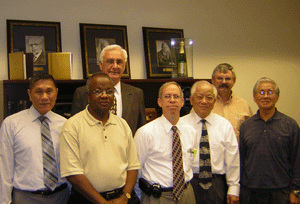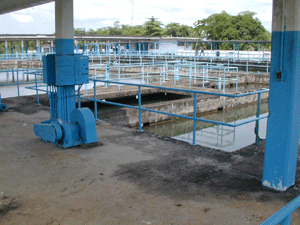
Bringing Adequate Safe Drinking Water to Monrovia, Very soon
By Abdoulaye W. Dukulé
Adukule@theperspective.org
The Perspective
Atlanta, Georgia
October 22, 2007
This situation is to soon find a remedy, thanks to collaborative efforts between the Government of Liberia, World Bank, European Commission, DFID/African Development Bank and AB&H, A Donohue Group, a Chicago-based engineering firm with some 100 years of engineering experience and which has been involved in Liberia since the 1950s. The firm designed the Monrovia water supply and distribution system, including the White Plains Water Treatment Plant and transmission main, as well as the pipe distribution network in Monrovia. The firm also designed the city’s sanitary sewage collection, conveyance, and treatment facilities.
 |
According to the Managing Director of the Liberia Water and Corporation Sewer (LSWC), Mr. Hun-Bu Tulay, the Chicago-based firm will conduct an assessment of the White Plains Water Treatment Plant and 36” finished water transmission main to determine the extent of damage. The assessment of the facilities will enable the firm to recommend an interim program that could be implemented in a few months to increase the amount of water supplied to Monrovia. The firm will also design a detailed rehabilitation work plan to ultimately restore the plant and transmission main to their pre-war capacities. The final aspect of the current contract is assisting the Government of Liberia secure a qualified contractor to build the designed rehabilitation works.
Mr. William G. Nyanue, a Liberian national with more than 25 years of engineering experience and a former Planning and Development Manager at the Liberia Water and Sewer Corporation, is manager of the project from the consultant’s Chicago office. He has been with AB&H, A Donohue Group for 16 years, having moved there during the Liberian conflict.
The project team includes Civil, Electrical, Hydraulic, Mechanical, Process, and Structural Engineers. Some of the members of the team are the original designers of the Monrovia water supply and distribution system.
Mr. William Meinholz, one of the firm’s senior Engineers with more than 45 years of experience will lead a five-person assessment team to Monrovia. He will be accompanied by Kou Chang, a Civil Engineer; Kenneth Chen, an Electrical Engineer; Charles Lawrence, a Process Engineer; and Steve Poland, a Structural Engineer. The team leaves Chicago on Saturday, October 20, 2007.
Monrovia receives its public potable water from the White Plains Water Treatment Plant, located about 18 miles southwest of the city. The plant obtains raw water from the St. Paul River.
 |
Prior to 1966, the city received its limited public potable water supply from a slow sand filtration plant in White Plains, rated at no more than 3 million gallons a day. Finished water from that plant was supplied to Monrovia through the 16” transmission main.
Following the end of Liberia’s fourteen-year civil war, the Liberia Water and Sewer Corporation staff carried out limited repairs at the White Plains Water Treatment Plant. With the plant’s raw water supply pipeline rendered unusable as a result of the destruction of the Mt. Coffee hydro dam, LWSC staff reverted to using the onsite river intake and low lift pumps for a raw water supply. The White Plains Water Treatment Plant currently supplies about 3 million gallons of water a day to parts of Monrovia. This represents just about 19 percent of the plant’s pre-war capacity.
For William Nyanue, this project is a matter of personal pride. He will be able to render great service to his home country while at the same time working with an institution where his career began decades ago. “This is what anyone in the Diaspora--most of us who have been exiled--can hope for: that while you are here, you can somehow contribute in a meaningful way to the national recovery process,” the Liberian Engineer said.
The AB&H, A Donohue Group’s assessment team will be in Monrovia for an entire week. The firm has already delivered to the LWSC record drawings of all water supply projects designed by the firm decades ago, including those of the White Plains Water Treatment Plan and the Monrovia water distribution pipe network which were lost or destroyed during the 14-year civil war.
This project is being financed from proceeds of a World Bank grant to Liberia for Emergency Infrastructure Projects, and is being managed on behalf of the Government of Liberia by the Special Implementation Unit (SIU) at the Ministry of Public Works.
© 2007 by The Perspective
E-mail: editor@theperspective.org
To Submit article for publication, go to the following URL: http://www.theperspective.org/submittingarticles.html